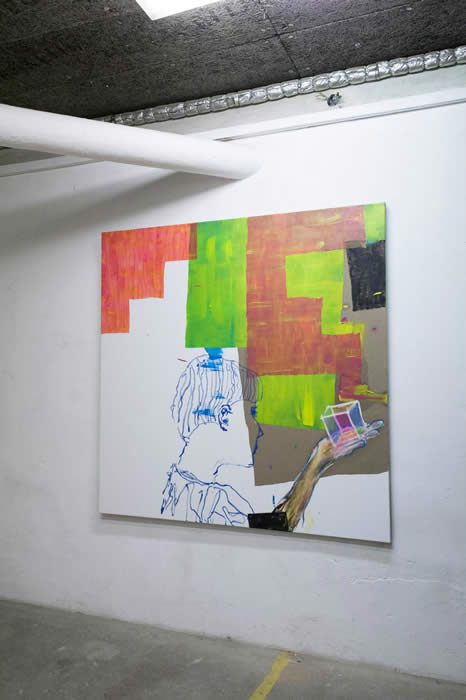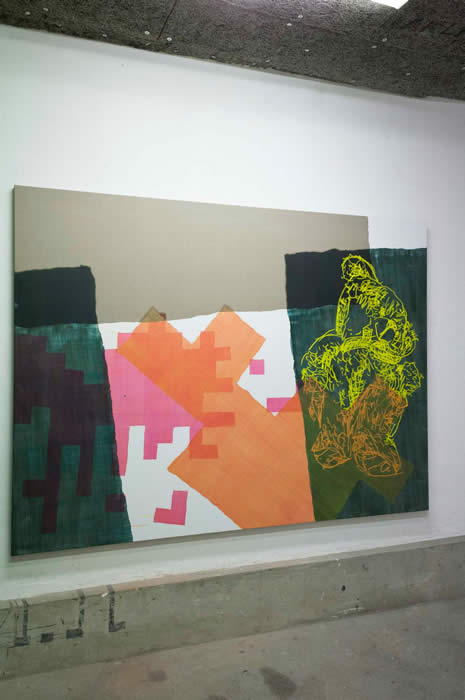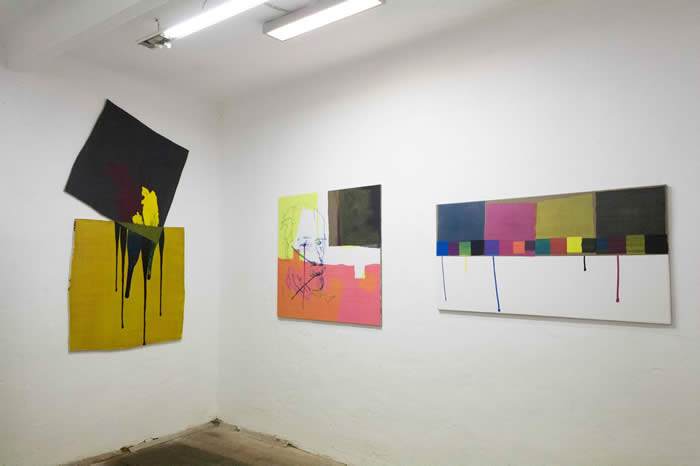Beyond Mimesis: Bartosz Sikorski – recursions
curated by Christian Bazant-Hegemark
14.10.2014 – 19.10.2014 mo.ë Vienna
https://beyondmimesis.tumblr.com
Bartosz Sikorski originally used the canvas’ square format to reference the computer screen’s pixel as one of contemporary life’s visual building blocks. This way, the canvas’ silhouette became the basic level of a recursion to be continued through the canvas space’s painted ciphers: there’s a fractal quality to some of Sikorski’s works, a visual self-referentialism used by the likes of M. C. Escher, Piet Mondrian, or in Katsushika Hokusai’s Great Wave off Kanagawa.
Sikorski’s understanding of mathematics is both visual and intuitive, and can be felt in his use of the canvas as sort of rhythm space, with compositional forms seemingly being permutated in a variety of scalings. Sikorski cares more about referencing other painting’s ideas and topologies than their direct visualities, resulting in a playful approach towards the medium that will probably take the viewer by surprise when initially seeing his work. He alternates ideas between various media, translating pixelations from the canvas into pixel-art sculptures, varying the Saussureian dichotomic model of signifier/signified up to its inversion – using the computer’s pixelated abstraction as visual reference (originally used to depict objects of the three-dimensional world, pixel-art today works mostly as self-referential historicism), Sikorski creates three-dimensional abstractions of the computer’s pixelated abstraction, now staged within the world: what developed out of a technical requirement has thus been canonized into a symbol for the time it was established in – like the steam locomotive or the walkman. Sikorski’s work can be seen as efforts to contextualize these kinds of canonical shifts.
Although on first encounter Sikorski’s paintings appear abstract, they are most often abstractions of something – referencing Da Vinci’s Last Supper, the Tree of Life, a fleeting Malevich square. This makes them touch a narrative field unusual for these kinds of works: when applying a dualistic thought model, one seemingly encounters artists creating visual abstractions of mental concretions more often than those creating mental abstractions of visual concretions. Sikorski’s paintings can be seen as art that doesn’t just grow, but actually ‘changes’ depending on the recipient’s level of meta-knowledge – of information that is not stored directly within the actual physical haptics of the artwork.
These semi-hidden narratives under the initial visual surface of Sikorski’s paintings hold a certain irony, a specific humor that acts as both opening and closure, as both increasing and decreasing dynamic within the recipient’s space. These access/entrance variations can be especially interesting when discussing abstract pieces like his; abstraction as younger-ish art historic topos way past canonization, as a field by now similarly pre-connotated as figuration. When it used to act as a promise of avant-garde, as tool to express both ‘unknown thought’ and ‘unthought known’ (the unknown), today it might serve more as yet another coequal set of canonized ciphers used to express the known. Canonization thus reduces the Burden of the New, allowing a certain playful access towards it. Like Keith Haring then, Sikorski takes what we supposedly knew, turns it around and shows something we didn’t expect.
Beyond Mimesis is a research and discourse platform investigating contemporary painting conditions curated by Christian Bazant-Hegemark.


